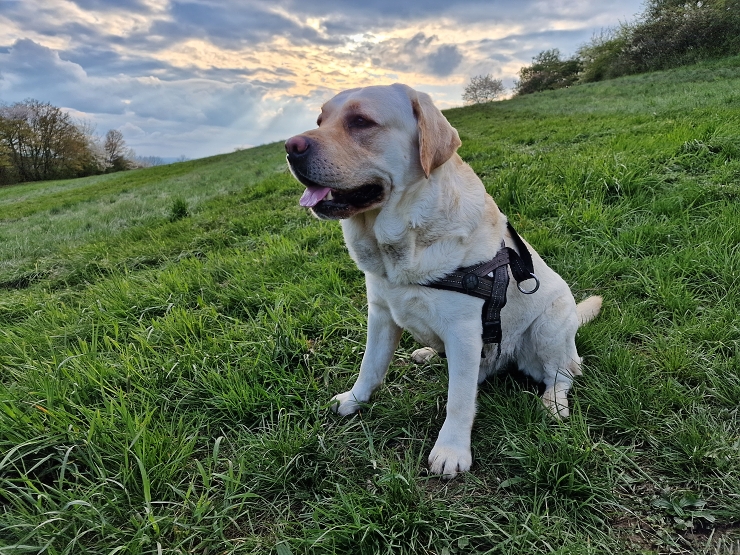Bez psích kamošů by bylo na světě jooo smutno. 😘
Dog skull from Tralleis
Categories: Nálezy nejenom s detektorem na blízkém východě
 This is a Labrador Retriever and the Romans didn't breed it. He comes from Newfoundland from the Water Dog St. John line. He is not a herding dog, nor a hunting or guarding dog, he is a licking dog. His name is Mance and he is a benevolent king behind the fence.
This is a Labrador Retriever and the Romans didn't breed it. He comes from Newfoundland from the Water Dog St. John line. He is not a herding dog, nor a hunting or guarding dog, he is a licking dog. His name is Mance and he is a benevolent king behind the fence.
Dogs are man's oldest friends and have been with us since the dawn of time. They perform the various tasks that humans put on them and are still indispensable in many activities. The Romans played a key role in shaping the modern dog breeds, giving them desirable morphological and functional characteristics through artificial selection. The earliest known skull of a dog was discovered in ancient Tralleis, which today we would probably associate with the French Bulldog.
Scientists agree that the Romans were the first to develop modern methods of selecting dogs that gave the breeds desirable characteristics. Evidence of this can be found in Columella's "De re Rustica" and Virgil's "Georgic", which describe three types of dogs: Canis villaticus (large guard dogs), Canis pastoralis (fast and hardy herding dogs) and Canis venaticus (larger than medium-sized hunting dogs). Small decorative dogs were not included in this classification and were called lap dogs.
Scientists from the Wrocław University of Environmental and Biological Sciences and Turkish universities carefully analysed the canine skull from the Roman period discovered in the ruins of ancient Tralleis (now Aydın) in southwestern Turkey1). Radiocarbon dating suggested that the skull dates from 169 BC. - 8 CE
Ancient sources such as texts, mosaics and sculptures provide information about what dogs looked like at the time. Artificial selection introduced by humans was a key factor in the variety of dog skull shapes. Scientists divide them into three main types: brachycephalic (short cranial), mesatic (medium cranial) and dolichocephalic (long cranial). In domestic mammals, differences in the shape and size of the canine skull are greater than in other species.
In ancient Rome and Greece, dogs were often depicted with dolichocephalic (elongated) and mesocephalic (proportional) skulls. Studies of dog skulls from the Byzantine period have shown predominantly mesocephalic and dolichocephalic skulls, with no brachycephalic (short-skulled) skulls.
However, the dog skull found at Tralleis has been shown to be brachycephalic (short-cranial). It is the second brachycephalic dog skull found in areas under Roman control and the oldest. There are many more in later centuries, such as those discovered in the port of Theodosius in the Yenikapi district of Istanbul. Although the skeleton of the tralleian animal is incomplete, it is clear that the dog was well treated and lived better than most Roman dogs, used mainly for work. It was probably a pet that did not live long. It died shortly after reaching adulthood and was buried near the man. Researchers speculate that the dog was killed when its master died and they were buried together.
Archaeozoological research reveals differences between ancient dogs and modern breeds. It is believed that the appearance of brachycephalic dogs was the result of the desires and wishes of the Romans. The long history of the relationship between man and dog has resulted in the creation of over 400 dog breeds, the variety of which continues to grow. The discovery of the brachycephalic skull of the tralleian dog is evidence of the Romans' involvement in breeding breeds with diversecharacteristics, contributing to the enrichment of the genetic heritage of our four-legged friends.
Source: archeologie.pl
The article is included in categories:
- Archive of articles > Archaeology > Finds and rescue research abroad > Nálezy nejenom s detektorem na blízkém východě
Post
Člověk a pes měl k sobě vždycky blízko. Už v dávnověku se vytvořila pevná vazba. Nejdřív jedli psi nás.....
To přetrvává, tahle potvora mě tady okusuje pořád 
Ten římský výběr plemen je zajímavý, dobrý článek.
Romane pro nás dva určitě ano. Mencík zdraví slečnu Fanku :)
Necháme pěkně děkovat a zdravici opětujeme. Sedíme s Fanky právě na rybách 

Tak to doufám, že to bere :)
Právě jsem dorazil a jednadvacet ryb chycených a puštěných. Jářku..., hovězí je hovězí 

Apropo.., ještě k těm psům.
Za ty roky tady jsem si všiml, že kombinaci detektorář - pes volí většina zdejších raději než kombinaci detektorář - žena. Pes nezdržuje, nerozčiluje, nekecá do toho, chrání, rozveseluje..., nevadí mu že: prší, fouká, je zima, je horko, jsou komáři, klíšťata, mouchy..., pomáhá: vyhrabávat, zahrabávat, nosit, hlídat a v neposlední řadě celým svým psím srdcem věrně a nadosmrti miluje. A to všechno bez nároku na honorář, tedy zcela zdarma. Pes je úžasné stvoření a já bez své psí společnice neudělám krok 










